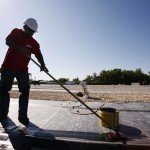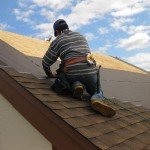Commercial and residential roofing each have their own challenges . While residential roofs must face issues with steep slopes, commercial roofs often face unique situations that call for a whole different set of procedures and roof materials. In general, roofs are divided into two categories: low slope and steep slope.
Low Slope Roofs
 A commercial roof is categorized as a low slope roof. Low slope roofs also include flat roof systems, which are quite common among commercial buildings. This type of roof is defined as a roof with a slope equal to or less than 14 degrees. The main focus for a low slope roof includes weatherproof membranes that offer structural support and beneficial surface components. Since low sloped roofs offer very little in terms of natural water deflection and drainage, waterproof materials are of high priority. Commercial roof materials must be able to strengthen the structure and provide elements such as fire resistance and solar reflectivity.
A commercial roof is categorized as a low slope roof. Low slope roofs also include flat roof systems, which are quite common among commercial buildings. This type of roof is defined as a roof with a slope equal to or less than 14 degrees. The main focus for a low slope roof includes weatherproof membranes that offer structural support and beneficial surface components. Since low sloped roofs offer very little in terms of natural water deflection and drainage, waterproof materials are of high priority. Commercial roof materials must be able to strengthen the structure and provide elements such as fire resistance and solar reflectivity.
Steep Slope Roofs
 Most residential roofs are categorized as steep slope roofs; however, some homes may be equipped with a low slope roof. Steep slope roofs are defined as a roof whose slope is greater than 14 degrees. A steep slope roof is made up of a three main parts. The roof deck is the structural base material, typically made up of plywood. The underlayment is a weatherproofing barrier that provides secondary coverage to the roof covering, or external weatherproofing material.
Most residential roofs are categorized as steep slope roofs; however, some homes may be equipped with a low slope roof. Steep slope roofs are defined as a roof whose slope is greater than 14 degrees. A steep slope roof is made up of a three main parts. The roof deck is the structural base material, typically made up of plywood. The underlayment is a weatherproofing barrier that provides secondary coverage to the roof covering, or external weatherproofing material.
The most common types of steep slope or residential roof material are asphalt shingles, clay or slate tile, concrete, metal roofs systems and wood shakes. Asphalt shingles, slate tiles and wood shakes are also available in synthetic varieties, which are made from a polymer-based material. Synthetic roof materials offer great benefits in that they are often recyclable, made from renewable resources, are longer lasting and more durable than their traditional counterparts.






